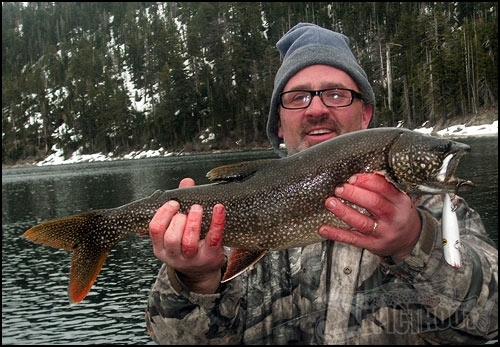Cigar chompin trout
The following is a classic article Mark Wiza wrote for a west coast fishing publication back in 2010. Some things never get old though, and Mark’s tips for trolling wooden cutt plugs are just as useful today. With Spring topline trolling time just around the corner, it’s time to bring this great read back for a new generation of anglers here at Epic Trout!
There’s nothing quite like discovering a new, hot lure. Even better, a lure that not only puts numbers of fish in the boat but also calls in the big ones. Best of all is if this lure is also so different in action and appearance from what your friends are using that they laugh at you for tying one on. That is until you outfish them faster than they can say “paradigm shift”, then they all want to know more about your improbable offering. Say hello to my new friend Lyman.
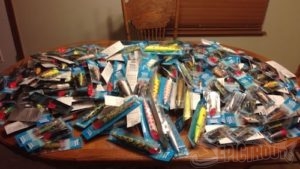
My good friend Brad Stout recently introduced me to this unique brand of trolling plug made in Canada that he has found to be highly effective for large Lahontan cutthroat trout on world-famous Pyramid Lake. Ten years ago, hardly any Pyramid anglers had even heard of a Lyman, and now it’s a standard lure for trollers. This was primarily caused by Brad constantly netting big cutts in front of the other boats and being asked what he was using! He was kind enough to show me his approach to pulling Lymans on Pyramid, and as we caught fish I learned that the four-inch model will get bites all day, but upsizing to the six or even nine-inch Lyman can bring in true trophy-size cutthroat.
These cigar-shaped wooden plugs fall under a broad class of lures I classify as ‘erratic action lures’. This group includes the similarly shaped J-Plug and Silver Horde, as well as tackle quite different in design and appearance, such as Apex and Sting King lures. The commonality is that in addition to a constant wiggling action when pulled through the water, these lures all have an additional darting or swooping motion, especially when trolled at an upbeat pace. This extra movement triggers a predatory response from game fish, as they see the prey they had been following make a sudden dart to the side, indicating either the irregular swimming cadence of an injured or dying fish that will make an easy meal, or the evasive maneuver of a healthy fish about to escape.
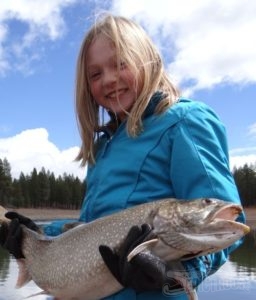
Pyramid Lake may not be a fair testing ground though, because the trout here will hit just about anything on a good day. But then I caught fish with Brad using Lymans on Donner Lake for mackinaw, and for brown trout on Stampede Reservoir. He generously gave me some to try out, and I began using them on Lake Tahoe, my home water. Right away I started catching small mackinaw, enough to keep me interested, and as I worked Lymans more often into ‘the rotation’ of my favorite trout trolling lures, I learned more each trip about how to run them properly, so my success increased. On one outing this spring on Tahoe, I introduced my friend Jeff Keyser to Lymans on lead core line, and he caught the best fish of the day, a seven-pound mackinaw. The next week I fished aboard my friend Jeff Turner’s boat, and we trolled traditional shallow water Tahoe lures such as Rapalas and Bombers for several hours without a bite, but when I let out a third line down the middle with a four-inch Lyman on lead core, that rod caught us five fish- four macks and a brown! Now not only did I have a new favorite lure but I also had two other guys who had initially made fun of my ‘box of cigars’ asking me where they could buy some.
Any lure capable of fooling Tahoe’s wary wild browns deserves a spot in my tackle box, but on my next trip in my little boat I focused on mackinaw, because on April 26, 2010, the Nevada Department of Wildlife planted over four thousand rainbow trout at Cave Rock State Park. As these hatchery fish disperse from the boat ramp, they ring the dinner bell for large lakers that move in to gorge on the easy prey.
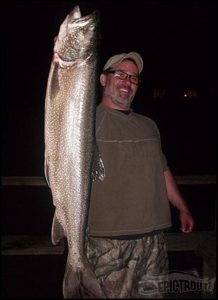
So the afternoon of May 12 found me in sunny conditions and slight chop, pulling six-inch rainbow trout pattern Lyman Lures on lead core in the thirty to sixty-foot zone, pounding the sandy bottom south of the ramp. After a couple of hours and several mile-long trolling passes in this key area, I had caught and released two macks around five pounds each, but on the next run my rod jerked over and kicked much more violently as the lightly set drag rapidly paid out line. Yes! This was the fish I was looking for! After a fun but relatively safe five-minute battle over the sandy bottom on ten-pound leader, I netted a lean, mean mackinaw that at 35 inches weighed just over fifteen pounds. Spring 2010 has turned out to be ‘the season of the Lyman’ for me, and I’ve been using this unique lure in more situations on more lakes each week, with great rewards. Here are a few tips to help new Lyman users:
1) Size: These lures are manufactured in lengths from 1.5 to 9 inches. My favorites are the 3 inch model for browns, the 6 inch for trophy mackinaw, and the 4 inch as a great all-species lure. These lures fish ‘bigger’ than their size, with the 4 inch model capable of attracting a ten-pound cutthroat or twenty-pound mack. I attribute this to the wild, darting action; the Lyman zig-zags so frantically while being trolled that it appears to be in two or three places at once! This attribute becomes more apparent the faster this lure is pulled, which brings me to the next subject-
2) Speed: The larger the Lyman, the faster you troll; it’s that simple. The 1.5 inch size darts wildly when trolled as slow as one mile per hour, making for a great speed/size combo when trolling behind dodgers or lake trolls for kokanee salmon or small trout . At the other end of the spectrum, the 9 inch Lyman requires around three miles per hour to bring out its best action. A reasonable approach when fishing for big trout with reasonable Lymans (3 to 6 inch) is to troll between two and three miles per hour, cycling through this speed range until you find what the fish want on any given day.
3) Depth: How deep should you troll your Lyman Lures? Troll ’em right above where the fish are. You’ll have to figure that one out on your own, because Lymans will catch fish from two feet to two hundred feet down.
Okay, here are a few hints. Some trophy trout fisheries feature bait species, from shad to kokanee salmon, that school over open water, far from the lake bottom. In these cases, you need to find the baitfish schools and present your Lyman (in the proper color pattern to imitate this prey species of course) in or just under the bait school as seen on your fish finder.
On my favorite west coast lakes though, the biggest trout are usually caught right close to the bottom, often near rocks, stumps, and other tackle-eating structure. “If you never hang bottom you’re not fishing” is a well-worn Tahoe adage, and if you follow the advice, your lures will be chipped and worn as well.
Though Lyman Lures can be trolled on a ‘flatline’ or ‘topline’ of straight monofilament, most users find them more effective when held down in the water column by lead core line or downriggers. The Lyman will dive a certain depth as well as dart left and right a certain distance based on the lure‘s size, given that you use a long leader on your lead core or a long setback on your downrigger, at least 50 to 100 feet. A short leader or setback will restrict the lure’s natural darting and diving action, as will adding a trolling sinker close to the lure. Here’s a chart of approximate diving depths I’ve found when trolling the following size Lymans on long leaders at 2 to 3 MPH:
The 3 inch Lyman will dive around three feet below the depth of the tip of your lead core or your downrigger ball, as well as darting the same distance to either side.
The 4 inch model will dive and dart five feet.
The 6 inch Lyman will need about ten feet of wiggling room,
and the monster 9 inch model will need fifteen feet of clearance below your downrigger ball to avoid bottom contact.

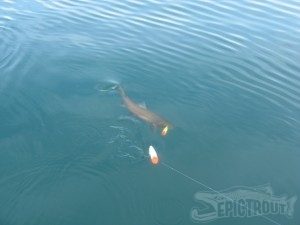
A final tip for trophy trout hunters trying Lyman Lures is that bottom contact is not to be avoided! In all but the most jagged of boulder fields and stump-studded channels, I try to hit the lake floor with the Lyman fairly often to trigger bottom-hugging fish. The shape of this lure and the way its front edge bounces off structure causes it to hang up much less often than plastic-lipped floater-divers such as Rapala and Rebel plugs, and my most heavily used Lymans have that bottom edge of their cupped faces worn away down to bare wood from frequent contact with the lake floor. Due to the high quality and curing process of the Canadian yellow cedar used for these plugs though, when the front edge is absolutely shredded from smashing rocks and digging through sand, Lymans still do not crack as some wooden plugs do when trolled at depth.
So next time you’re trolling and you can’t buy a bite on tight-wiggling minnow plugs or wide-wobbling Flatfish, why not try something completely different? Tie on a Lyman, then get ready for some cigar chomping trout!
Until Next Time!
Mark (Never Stand In A Canoe) Wiza
Mark is a licensed fishing guide offering a small number of fun and highly educational trout-fishing trips in the Tahoe area. Call (530) 545-1475, e-mail markwiza@yahoo.com or visitmarkwiza.com for more information.

